Notes: The construction of a railway north from Birmingham Snow Hill to Priestfield, where it would meet the Oxford, Worcester & Wolverhampton Railway (OW&WR) was authorised on 3 August 1846 to the Birmingham, Wolverhampton & Dudley Railway (BW&DR). The BW&DR favoured leasing the line to the Great Western Railway (GWR) from the outset as it planned the line to be constructed to the GWR’s broad gauge (7ft 0¼in) rather than what was, increasingly, the standard gauge (4ft 8½in). Negotiations with the GWR in regard to leasing and running the line started on 12 November 1846, only months after the railway company had been incorporated, and by Act of Parliament of 31 August 1848 the BW&DR was purchased by the GWR prior to any construction taking place. Construction of the line was started by the GWR during 1851 and by June 1852 the original Act was due to lapse and the GWR successfully applied to Parliament for a 3½-year extension to the original Act. The GWR had attempted not to construct the line at all preferring to negotiate with the London & North Western Railway (LNWR) to gain running rights along the Stour Valley line; negotiations failed as the, ever suspicious, LNWR was attempting to delay the GWR reaching its ultimate goal, Liverpool.
Construction was complete by the summer of 1854 and the line was duly inspected by Captain Sir Douglas Strutt-Galton in August. It is not recorded whether or not the inspection was a success, but, the following day a tubular bridge over the turnpike road at Winson Green collapsed following the passage of a contractor’s locomotive working a ballast train. Isambard Kingdom Brunel visited the line the following day and a thorough inspection of the bridges along the route with John Mc Clean, the resident engineer, resulted in five of them being condemned. The opening of the line had been set for 1 September 1854 but this was now unachievable as remedial work on the structures was to take some months. Following the strengthening of the five bridges the line was again inspected and passed fit for traffic, opening on 14 November 1854.
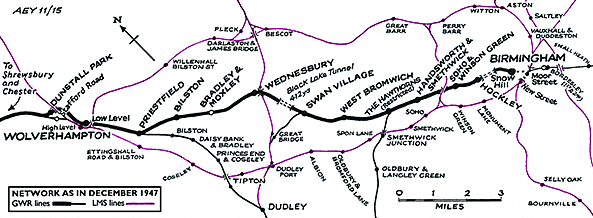
Swan Village station opened on 14 November 1854 and was constructed as a two platform affair with two tall, single-storey wooden buildings, of roughly equal size, on each platform. They had a somewhat ungainly appearance produced by their ridged roofs which swept forward, supported by numerous wooden braces, to shelter the adjacent platforms. No goods facilities were provided. Access to the station was provided via a small driveway off Bilhay Lane and a pedestrian entrance from Swan Lane (which led to the Birmingham-bound platform) a further pedestrian entrance was provided via a flight of steps from Bilhay Lane which led to the southern end of the Wolverhampton platform. A latticework footbridge was provided between the two platforms. The GWR was keen to shorten the circuitous route taken by trains travelling along the former OWWR line from Dudley to Birmingham Snow Hill; this involved trains from Dudley, .gif) heading for Snow Hill, travelling all the way to Wolverhampton Low Level where a reversal took place. As part of the original BW&DR Act of Parliament, granted 3 August 1846, a direct route via Horsley Fields was authorised. This took the form of a 1 ½ mile branch commencing at a junction immediately south of Swan Village station connecting with the LNWR South Staffordshire at Horsley Fields, opening on 1 September 1866. The branch would also serve the large Swan Village Gas Works and the Swan Village Canal Basin which opened in 1869. Two additional platforms were constructed, to the west of the original platforms, these opening on the same day. Large wooden waiting shelters with flat awnings – far more conventional in appearance than the existing buildings on the ‘main line’ platforms - were provided on both of the branch line platforms; the main station buildings were retained on the main line platforms; a footbridge connected the two new platforms. heading for Snow Hill, travelling all the way to Wolverhampton Low Level where a reversal took place. As part of the original BW&DR Act of Parliament, granted 3 August 1846, a direct route via Horsley Fields was authorised. This took the form of a 1 ½ mile branch commencing at a junction immediately south of Swan Village station connecting with the LNWR South Staffordshire at Horsley Fields, opening on 1 September 1866. The branch would also serve the large Swan Village Gas Works and the Swan Village Canal Basin which opened in 1869. Two additional platforms were constructed, to the west of the original platforms, these opening on the same day. Large wooden waiting shelters with flat awnings – far more conventional in appearance than the existing buildings on the ‘main line’ platforms - were provided on both of the branch line platforms; the main station buildings were retained on the main line platforms; a footbridge connected the two new platforms.
The mixed gauge line was converted to standard gauge during 1869.
Analysis of Bradshaw’s December 1895 timetable shows that the station was served by 17 down services through the main line platforms (Wolverhampton direction) and 11 services through the branch platforms (Dudley direction) on weekdays. In the up (Birmingham) direction there were 16 main line departures with 11 branch line departures. It is worthy of note that of the branch line departures seven in each direction were main line express services either to or from London Paddington. This through running of such express services had been introduced by the GWR to increase capacity at Snow Hill with the down service stock being serviced at Dudley. The Sunday timetable shows a total of 13 services in each direction with seven passing through on the main lines and six through the branch platforms: half of the branch departures were London services.
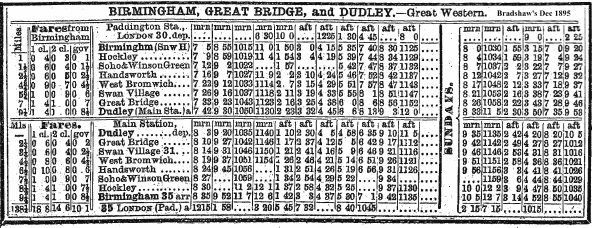
As with many stations the First World War brought a reduction in service frequency, mainly to release men to help the war effort. The withdrawal of the Snow Hill to Dudley services occurred on 29 November 1915 with the fewer London trains travelling through Wolverhampton to Oxley for servicing. The Snow Hill to Dudley service resumed in January 1920 although Sunday services along the branch were never reintroduced. Bradshaw’s July 1922 timetable shows that the weekday services to have returned to their pre-war levels, the down (Wolverhampton/Dudley) direction having 29 departures with 17 being main line services and 12 branch line. The up (Birmingham) direction had 30 daily departures with 17 main line and 13 branch line. It is to be noted that the Dudley service was now marked in the timetable as ‘Motor Cars – One Class only’ indicating that the halcyon days of London expresses up and down the branch were now over.
At the time of the Big Four ‘Grouping’ of 1 January 1923 Swan Village remained under the control of the GWR.
On 1 January 1948 the railways were nationalised and Swan Village came under the control of British Railways (BR) Western Region (WR). During the London Midland Region’s (LMR) electrification programme of the West Coast main line (WCML), started in 1958, the line saw an 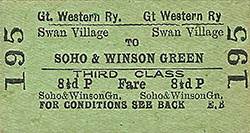 increase in passenger services as many extra trains were run via the WR metals to compensate for the reduction in services on the WCML. Although this did not affect the service at Swan Village it seemed to cement the former GWR route as still being a primary main line. Plans revealed by BR (WR) in the early 1960s for the rebuilding of Snow Hill and the introduction of new diesel Pullman services all pointed towards the future being bright. On 1 January 1963 boundaries for BR regions were re-drawn and Swan Village station came under the control of BR (LMR), and with the completion of the electrification programme and the linking of the main line from Paddington to Birmingham New Street the route north of Snow Hill was considered secondary. increase in passenger services as many extra trains were run via the WR metals to compensate for the reduction in services on the WCML. Although this did not affect the service at Swan Village it seemed to cement the former GWR route as still being a primary main line. Plans revealed by BR (WR) in the early 1960s for the rebuilding of Snow Hill and the introduction of new diesel Pullman services all pointed towards the future being bright. On 1 January 1963 boundaries for BR regions were re-drawn and Swan Village station came under the control of BR (LMR), and with the completion of the electrification programme and the linking of the main line from Paddington to Birmingham New Street the route north of Snow Hill was considered secondary.
In the late 1950s or early 1960s the original station buildings were demolished by the WR and the station was totally rebuilt in a functional style. The new, self-effacing brick buildings with flat roofs were as bland and unenterprising as their predecessors were distinctive. They were probably praised at the time for their ‘clean lines’ – the vocabulary used in the 1950s and ‘60s for the public toilets which Swan Village’s buildings resembled. The original driveway to the station was removed and a new access route, large enough to accept buses as well as cars, was constructed from Swan Lane to the new station forecourt. The flight of steps from Bilhay Lane was retained as this gave convenient access from the numerous dwellings nearby.
The, now infamous, report published in 1963 by Dr Richard Beeching, The Reshaping of British Railways made the recommendation for the withdrawal of the passenger service between Swan Village and Great Bridge - the branch service. These were withdrawn on 15 June 1964 although the line was retained for freight to service the Swan Village Basin. Freight lingered on until the basin closed on 5 December 1967, with official closure of the line following on 1 January 1968. The report made no mention of the main line through the station.
In 1966 BR (LMR) issued a proposal to close the Birmingham Snow Hill to Wolverhampton Low Level route, and all stations, in its entirety. In 1966 there were 24 trains in each direction to and from Wolverhampton, with around 2,000 people per day travelling on them (figure includes Snow Hill to Langley Green shuttle). Objections were posted to the Transport Users’ Consultative Committee (TUCC) and the case for closure was discussed on 20 September 1966. The recommendation of the TUCC was the line was to remain open as closure would cause ‘extreme.gif) hardship’. This ruling caused the LMR to change tactics with the announcement that as of 4 March 1967 the main line trains along the whole route would be withdrawn and freight trains diverted along other routes. On 15 November 1967 the Minister of Transport, Barbara Castle responded to BR’s application, refusing to allow the closure of the Wolverhampton to Snow Hill and the branch to Langley Green, but allowing the closure of the southern section from Snow Hill towards Stratford and Leamington. The LMR reduced the service level with the introduction of the May 1968 timetable in which Swan Village saw just 18 down (Wolverhampton direction) services on Monday-to-Saturday, whilst the up workings consisted of 20 Monday-to-Saturday trains and the Sunday service was withdrawn. From May 1969 the service was reduced even further to just six workings each way on Monday-to-Friday and seven on Saturday as the LMR attempted to undermine the line’s viability by running as few trains as possible: the station at Swan Village lost its complement of staff at the same time. Unlike many other stations along the route the platform buildings were retained following the withdrawal of station staff although the infrastructure slowly started to decay from a combination of vandalism, brought on by the absence of staff, and a general lack of maintenance; certainly not conducive to attract new, or even retain, passengers - but that was the intention. Between May 1969 and March 1972 the service remained at a constant level of six trains each way on Monday-to-Friday with one extra working on Saturday, in the early afternoon, to cater for shoppers wishing to travel to Birmingham hardship’. This ruling caused the LMR to change tactics with the announcement that as of 4 March 1967 the main line trains along the whole route would be withdrawn and freight trains diverted along other routes. On 15 November 1967 the Minister of Transport, Barbara Castle responded to BR’s application, refusing to allow the closure of the Wolverhampton to Snow Hill and the branch to Langley Green, but allowing the closure of the southern section from Snow Hill towards Stratford and Leamington. The LMR reduced the service level with the introduction of the May 1968 timetable in which Swan Village saw just 18 down (Wolverhampton direction) services on Monday-to-Saturday, whilst the up workings consisted of 20 Monday-to-Saturday trains and the Sunday service was withdrawn. From May 1969 the service was reduced even further to just six workings each way on Monday-to-Friday and seven on Saturday as the LMR attempted to undermine the line’s viability by running as few trains as possible: the station at Swan Village lost its complement of staff at the same time. Unlike many other stations along the route the platform buildings were retained following the withdrawal of station staff although the infrastructure slowly started to decay from a combination of vandalism, brought on by the absence of staff, and a general lack of maintenance; certainly not conducive to attract new, or even retain, passengers - but that was the intention. Between May 1969 and March 1972 the service remained at a constant level of six trains each way on Monday-to-Friday with one extra working on Saturday, in the early afternoon, to cater for shoppers wishing to travel to Birmingham  or Wolverhampton. Passenger numbers had dwindled to one tenth of what they had been in 1966, and on 31 March 1971 the LMR made its move and posted closure notices for Wolverhampton Low Level to Birmingham Snow Hill, including the Langley Green shuttle; objections had to be received by 19 May 1971. The Transport Users’ Consultative Committee received 199 objections in total and on 25 May, they, along with representatives from BR and WMPTE (the Executive body of the WMPTA), inspected the route and all the stations, travelling from Snow Hill by train to Wolverhampton; ironically they returned by bus! A Public Hearing was held at the Rainbow Suite in Birmingham on 14 July 1971 to listen to objections and decide the future of the line. The statement issued by the TUCC could not have been clearer: ‘The addition of displaced rail passengers at these times would aggravate an already critical situation and would result in hardship for all concerned’. Nevertheless, on 24 January 1972 the Minister granted permission for closure to be implemented with a date quickly set for 4 March. On the final day trains were expected to be heavily patronised, so, instead of being the usual single car DMU the trains were strengthened to three-car units with BR issuing souvenir tickets. The final Wolverhampton-bound train called at Swan Village at 6.05pm, the final Birmingham-bound service having departed at 6.02pm. or Wolverhampton. Passenger numbers had dwindled to one tenth of what they had been in 1966, and on 31 March 1971 the LMR made its move and posted closure notices for Wolverhampton Low Level to Birmingham Snow Hill, including the Langley Green shuttle; objections had to be received by 19 May 1971. The Transport Users’ Consultative Committee received 199 objections in total and on 25 May, they, along with representatives from BR and WMPTE (the Executive body of the WMPTA), inspected the route and all the stations, travelling from Snow Hill by train to Wolverhampton; ironically they returned by bus! A Public Hearing was held at the Rainbow Suite in Birmingham on 14 July 1971 to listen to objections and decide the future of the line. The statement issued by the TUCC could not have been clearer: ‘The addition of displaced rail passengers at these times would aggravate an already critical situation and would result in hardship for all concerned’. Nevertheless, on 24 January 1972 the Minister granted permission for closure to be implemented with a date quickly set for 4 March. On the final day trains were expected to be heavily patronised, so, instead of being the usual single car DMU the trains were strengthened to three-car units with BR issuing souvenir tickets. The final Wolverhampton-bound train called at Swan Village at 6.05pm, the final Birmingham-bound service having departed at 6.02pm.
The speed of the closure caught the timetable compilers unawares as the BR (LMR) publication of 1 May 1972 showed a phantom service of the familiar six Monday-to-Friday trains (seven on Saturday) in each direction between Birmingham Snow Hill and Wolverhampton Low Level, albeit with a warning that ‘the Department of the Environment has under consideration the withdrawal of this service … in the event of this taking place during the currency of the Timetable appropriate notice will be given’.

The branch platforms, by the time the Wolverhampton to Snow Hill passenger services were withdrawn, were completely overgrown having been out of use for some four years. The rest of the station was basically left to decay; the main building was boarded up and nature was left to take over the platforms. Shortly after the withdrawal of passenger services the line north of the station was singled with just the up (Birmingham direction) main remaining. The line remained open for .gif) trains running to the Swan Village Coal Concentration Depot owned by Lunt, Comley & Pitt situated north of the station off Black Lake. Trains would run from Wednesbury to a point just north of the station site where they could set back into the depot sidings. The train would then reverse into the lengthy siding, where the engine could run round its train and set the train back into the depot sidings. A reversal back out, from the lengthy siding would have the train run back towards Wednesbury. The final train ran in December 1981 with the official closure date of the section of line from Wednesbury to Swan Village given as 12 December 1981. The lines through the station were lifted shortly after closure with the trackbed infilled. A linear park was established which ran along the course of the line to West Bromwich station and included the Swan Village station site. The down (Wolverhampton direction) platform was retained as a feature whilst the Birmingham bound platform was demolished. An industrial estate had already been constructed over the site of the branch platforms. trains running to the Swan Village Coal Concentration Depot owned by Lunt, Comley & Pitt situated north of the station off Black Lake. Trains would run from Wednesbury to a point just north of the station site where they could set back into the depot sidings. The train would then reverse into the lengthy siding, where the engine could run round its train and set the train back into the depot sidings. A reversal back out, from the lengthy siding would have the train run back towards Wednesbury. The final train ran in December 1981 with the official closure date of the section of line from Wednesbury to Swan Village given as 12 December 1981. The lines through the station were lifted shortly after closure with the trackbed infilled. A linear park was established which ran along the course of the line to West Bromwich station and included the Swan Village station site. The down (Wolverhampton direction) platform was retained as a feature whilst the Birmingham bound platform was demolished. An industrial estate had already been constructed over the site of the branch platforms.
The West Midlands Passenger Transport Authority (WMPTA) had long recognised the importance of the Wolverhampton to Birmingham Snow Hill route, although it became responsible for rail services only in 1972 so nothing could be done to stop the initial closure. On 31 October 1973 the Authority and its Executive body took steps to protect the trackbed from any future development so that some kind of public transport system could be reintroduced. The Authority’s first success was the rebuilding of Snow Hill, in the late 1980s, and the introduction of heavy rail services north of the station to Stourbridge and Kidderminster in 1995. With the first Metro proposal having to be abandoned owing to public opinion and construction difficulties, the route of the former relief lines from Snow Hill to Swan Village and onward using the trackbed of the former double-track main line to Wolverhampton was chosen. The WMPTA announced this on 16 February 1988 and on 16 November 1989 an Act of Parliament was granted for its construction. It was not until 3 August 1995 that the contract for construction was let to Altram, a consortium of Ansaldo and John Laing, with construction commencing on 13 November. The final section of track was laid on 4 February 1998 with public services beginning on 31 May 1999. A new tram stop bearing the name Black Lake is located just to the north of the original station site.
Today nothing remains of the station with the Wolverhampton platform being swept away in the construction of the Metro. The only evidence unearthed is the bricked-up aperture from which the stairs ran to the Wolverhampton platform from Bilhay Lane.
Tickets from Michael Stewart , route map by Alan Young and Totem from Richad Furness
Sources:
- Bradshaw's Railway Guide December 1895 - Middleton Press
- Bradshaw's Railway Guide July 1922 - Guild Publishing
- British Railways (WR) May - September timetble 1949
- British Rail (LMR) 3 May 1971 - 30 April 1972 timetable
- Forgotten Railways: Volume 10, The West Midlands - Rex Christinsen - David & Charles Publishing 1985
- A Regional History of the Railways of Great Britain - Volume 7 The West Midlands - Rex Christiansen - David St John Thomas Publisher 1991
- A Century of Railways around Birmingham and the West Midlands Vol 1,2 & 3 - John Boynton - Mid England Books Publisher 1999
- From Main Line To Metro - John Boynton - Mid England Books 2001
-
To see the
other stations on the Birmingham Snow Hill - Chester General line
click on the station name: Birmingham Snow Hill, Hockley, Winson Green,
Handsworth, The Hawthorns, West Bromwich, Wednesbury, Bradley & Moxley, Bilston, Priestfield, Wolverhampton Low Level, Dunstall Park, Stafford Road, New Hadley Halt, Admaston Halt, Walcot, Upton Magna, Abbey Foregate, Shrewsbury S&C, Leaton, Oldwoods Halt, Baschurch, Stanwardine Halt, Haughton Halt, Rednal & West Felton, Whittington Low Level, Weston Rhyn, Whitehurst Halt, Rhosymedre, Rhosymedre Halt, Wynville Halt, Rhos,
Johnstown & Hafod, Rhosrobin Halt, Gresford, Rossett,
Pulford, Balderton and Saltney
|

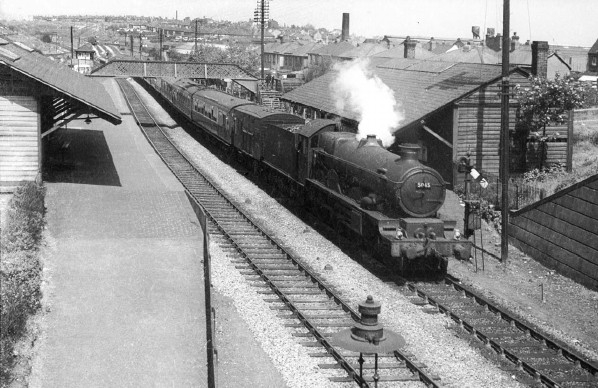
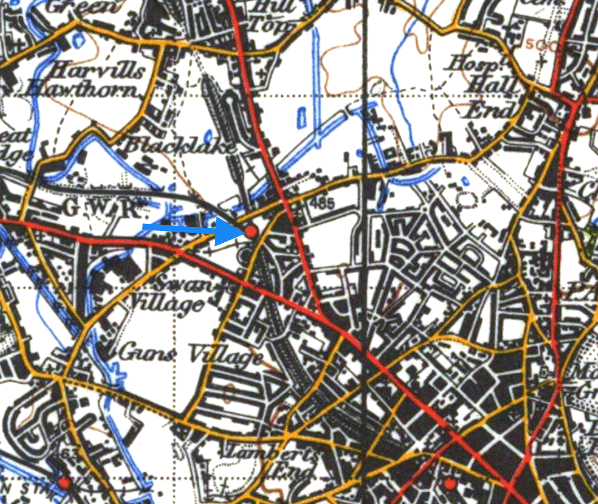
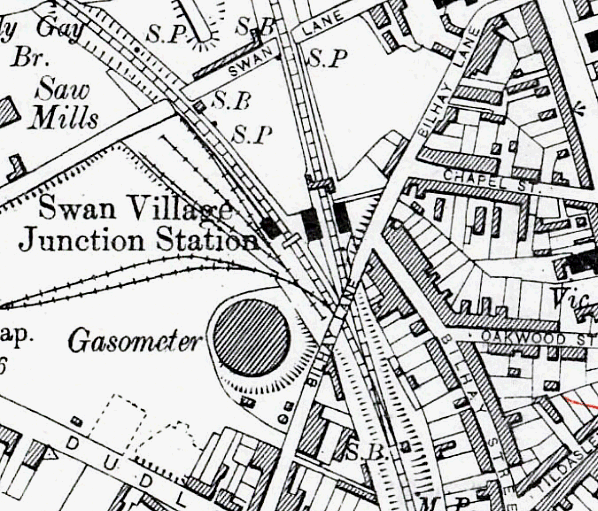 The 1912 six inch map shows the station and its close proximity to the gasometer and local housing.
The 1912 six inch map shows the station and its close proximity to the gasometer and local housing.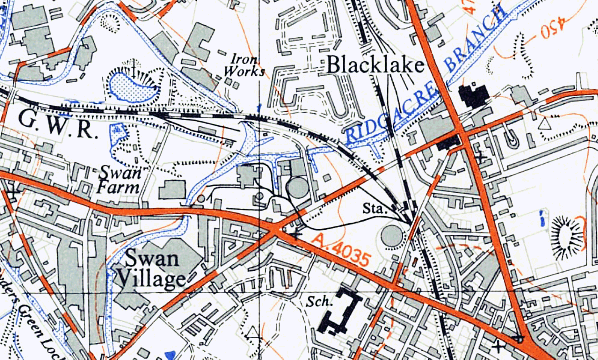 The 1937 1:25000 OS map shows the Swan Village basin along with the Blacklake sidings.
The 1937 1:25000 OS map shows the Swan Village basin along with the Blacklake sidings.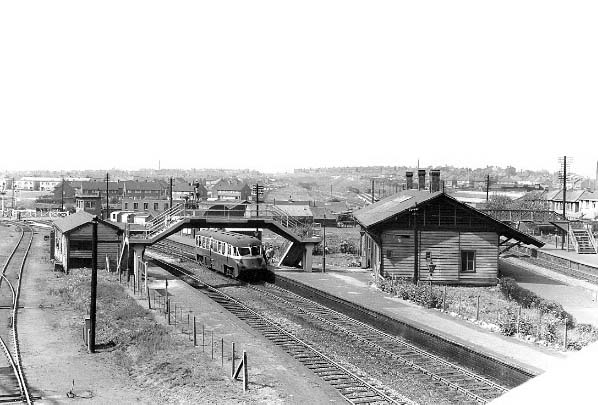 Looking from the Bilhay Lane overbridge at the branch line and main line platforms in 'as built' condition. Gloucester RCW built railcar W8 departs with a Dudley to Birmingham Snow Hill service, the car was constructed in 1936 and was withdrawn from Stourbridge shed during January 1959.
Looking from the Bilhay Lane overbridge at the branch line and main line platforms in 'as built' condition. Gloucester RCW built railcar W8 departs with a Dudley to Birmingham Snow Hill service, the car was constructed in 1936 and was withdrawn from Stourbridge shed during January 1959.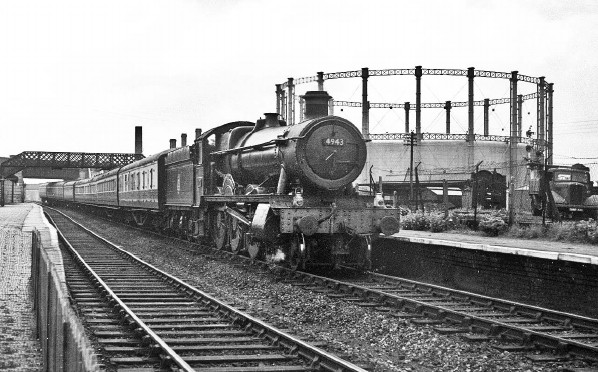
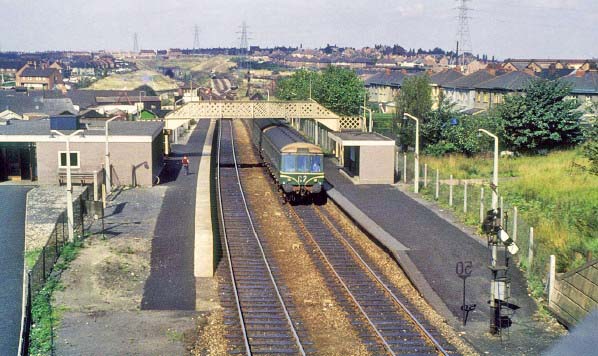 Swan Village station, in the early 1960s, shortly after re-building was complete. Clean functional buildings along with fresh tarmac and a new Wolverhampton bound platform edge point towards a bright future for the station. A Derby Surburban (Class 116) DMU stands in the Birmingham bound platform whilst a steam loco can be glimpsed in the Blacklake sidings.
Swan Village station, in the early 1960s, shortly after re-building was complete. Clean functional buildings along with fresh tarmac and a new Wolverhampton bound platform edge point towards a bright future for the station. A Derby Surburban (Class 116) DMU stands in the Birmingham bound platform whilst a steam loco can be glimpsed in the Blacklake sidings.
totem.gif)

.gif) heading for Snow Hill, travelling all the way to Wolverhampton Low Level where a reversal took place. As part of the original BW&DR Act of Parliament, granted 3 August 1846, a direct route via Horsley Fields was authorised. This took the form of a 1 ½ mile branch commencing at a junction immediately south of Swan Village station connecting with the LNWR South Staffordshire at Horsley Fields, opening on 1 September 1866. The branch would also serve the large Swan Village Gas Works and the Swan Village Canal Basin which opened in 1869. Two additional platforms were constructed, to the west of the original platforms, these opening on the same day. Large wooden waiting shelters with flat awnings – far more conventional in appearance than the existing buildings on the ‘main line’ platforms - were provided on both of the branch line platforms; the main station buildings were retained on the main line platforms; a footbridge connected the two new platforms.
heading for Snow Hill, travelling all the way to Wolverhampton Low Level where a reversal took place. As part of the original BW&DR Act of Parliament, granted 3 August 1846, a direct route via Horsley Fields was authorised. This took the form of a 1 ½ mile branch commencing at a junction immediately south of Swan Village station connecting with the LNWR South Staffordshire at Horsley Fields, opening on 1 September 1866. The branch would also serve the large Swan Village Gas Works and the Swan Village Canal Basin which opened in 1869. Two additional platforms were constructed, to the west of the original platforms, these opening on the same day. Large wooden waiting shelters with flat awnings – far more conventional in appearance than the existing buildings on the ‘main line’ platforms - were provided on both of the branch line platforms; the main station buildings were retained on the main line platforms; a footbridge connected the two new platforms.
 increase in passenger services as many extra trains were run via the WR metals to compensate for the reduction in services on the WCML. Although this did not affect the service at Swan Village it seemed to cement the former GWR route as still being a primary main line. Plans revealed by BR (WR) in the early 1960s for the rebuilding of Snow Hill and the introduction of new diesel Pullman services all pointed towards the future being bright. On 1 January 1963 boundaries for BR regions were re-drawn and Swan Village station came under the control of BR (LMR), and with the completion of the electrification programme and the linking of the main line from Paddington to Birmingham New Street the route north of Snow Hill was considered secondary.
increase in passenger services as many extra trains were run via the WR metals to compensate for the reduction in services on the WCML. Although this did not affect the service at Swan Village it seemed to cement the former GWR route as still being a primary main line. Plans revealed by BR (WR) in the early 1960s for the rebuilding of Snow Hill and the introduction of new diesel Pullman services all pointed towards the future being bright. On 1 January 1963 boundaries for BR regions were re-drawn and Swan Village station came under the control of BR (LMR), and with the completion of the electrification programme and the linking of the main line from Paddington to Birmingham New Street the route north of Snow Hill was considered secondary. .gif) hardship’. This ruling caused the LMR to change tactics with the announcement that as of 4 March 1967 the main line trains along the whole route would be withdrawn and freight trains diverted along other routes. On 15 November 1967 the Minister of Transport, Barbara Castle responded to BR’s application, refusing to allow the closure of the Wolverhampton to Snow Hill and the branch to Langley Green, but allowing the closure of the southern section from Snow Hill towards Stratford and Leamington. The LMR reduced the service level with the introduction of the May 1968 timetable in which Swan Village saw just 18 down (Wolverhampton direction) services on Monday-to-Saturday, whilst the up workings consisted of 20 Monday-to-Saturday trains and the Sunday service was withdrawn. From May 1969 the service was reduced even further to just six workings each way on Monday-to-Friday and seven on Saturday as the LMR attempted to undermine the line’s viability by running as few trains as possible: the station at Swan Village lost its complement of staff at the same time. Unlike many other stations along the route the platform buildings were retained following the withdrawal of station staff although the infrastructure slowly started to decay from a combination of vandalism, brought on by the absence of staff, and a general lack of maintenance; certainly not conducive to attract new, or even retain, passengers - but that was the intention. Between May 1969 and March 1972 the service remained at a constant level of six trains each way on Monday-to-Friday with one extra working on Saturday, in the early afternoon, to cater for shoppers wishing to travel to Birmingham
hardship’. This ruling caused the LMR to change tactics with the announcement that as of 4 March 1967 the main line trains along the whole route would be withdrawn and freight trains diverted along other routes. On 15 November 1967 the Minister of Transport, Barbara Castle responded to BR’s application, refusing to allow the closure of the Wolverhampton to Snow Hill and the branch to Langley Green, but allowing the closure of the southern section from Snow Hill towards Stratford and Leamington. The LMR reduced the service level with the introduction of the May 1968 timetable in which Swan Village saw just 18 down (Wolverhampton direction) services on Monday-to-Saturday, whilst the up workings consisted of 20 Monday-to-Saturday trains and the Sunday service was withdrawn. From May 1969 the service was reduced even further to just six workings each way on Monday-to-Friday and seven on Saturday as the LMR attempted to undermine the line’s viability by running as few trains as possible: the station at Swan Village lost its complement of staff at the same time. Unlike many other stations along the route the platform buildings were retained following the withdrawal of station staff although the infrastructure slowly started to decay from a combination of vandalism, brought on by the absence of staff, and a general lack of maintenance; certainly not conducive to attract new, or even retain, passengers - but that was the intention. Between May 1969 and March 1972 the service remained at a constant level of six trains each way on Monday-to-Friday with one extra working on Saturday, in the early afternoon, to cater for shoppers wishing to travel to Birmingham  or Wolverhampton. Passenger numbers had dwindled to one tenth of what they had been in 1966, and on 31 March 1971 the LMR made its move and posted closure notices for Wolverhampton Low Level to Birmingham Snow Hill, including the Langley Green shuttle; objections had to be received by 19 May 1971. The Transport Users’ Consultative Committee received 199 objections in total and on 25 May, they, along with representatives from BR and WMPTE (the Executive body of the WMPTA), inspected the route and all the stations, travelling from Snow Hill by train to Wolverhampton; ironically they returned by bus! A Public Hearing was held at the Rainbow Suite in Birmingham on 14 July 1971 to listen to objections and decide the future of the line. The statement issued by the TUCC could not have been clearer: ‘The addition of displaced rail passengers at these times would aggravate an already critical situation and would result in hardship for all concerned’. Nevertheless, on 24 January 1972 the Minister granted permission for closure to be implemented with a date quickly set for 4 March. On the final day trains were expected to be heavily patronised, so, instead of being the usual single car DMU the trains were strengthened to three-car units with BR issuing souvenir tickets. The final Wolverhampton-bound train called at Swan Village at 6.05pm, the final Birmingham-bound service having departed at 6.02pm.
or Wolverhampton. Passenger numbers had dwindled to one tenth of what they had been in 1966, and on 31 March 1971 the LMR made its move and posted closure notices for Wolverhampton Low Level to Birmingham Snow Hill, including the Langley Green shuttle; objections had to be received by 19 May 1971. The Transport Users’ Consultative Committee received 199 objections in total and on 25 May, they, along with representatives from BR and WMPTE (the Executive body of the WMPTA), inspected the route and all the stations, travelling from Snow Hill by train to Wolverhampton; ironically they returned by bus! A Public Hearing was held at the Rainbow Suite in Birmingham on 14 July 1971 to listen to objections and decide the future of the line. The statement issued by the TUCC could not have been clearer: ‘The addition of displaced rail passengers at these times would aggravate an already critical situation and would result in hardship for all concerned’. Nevertheless, on 24 January 1972 the Minister granted permission for closure to be implemented with a date quickly set for 4 March. On the final day trains were expected to be heavily patronised, so, instead of being the usual single car DMU the trains were strengthened to three-car units with BR issuing souvenir tickets. The final Wolverhampton-bound train called at Swan Village at 6.05pm, the final Birmingham-bound service having departed at 6.02pm. 
.gif) trains running to the Swan Village Coal Concentration Depot owned by Lunt, Comley & Pitt situated north of the station off Black Lake. Trains would run from Wednesbury to a point just north of the station site where they could set back into the depot sidings. The train would then reverse into the lengthy siding, where the engine could run round its train and set the train back into the depot sidings. A reversal back out, from the lengthy siding would have the train run back towards Wednesbury. The final train ran in December 1981 with the official closure date of the section of line from Wednesbury to Swan Village given as 12 December 1981. The lines through the station were lifted shortly after closure with the trackbed infilled. A linear park was established which ran along the course of the line to West Bromwich station and included the Swan Village station site. The down (Wolverhampton direction) platform was retained as a feature whilst the Birmingham bound platform was demolished. An industrial estate had already been constructed over the site of the branch platforms.
trains running to the Swan Village Coal Concentration Depot owned by Lunt, Comley & Pitt situated north of the station off Black Lake. Trains would run from Wednesbury to a point just north of the station site where they could set back into the depot sidings. The train would then reverse into the lengthy siding, where the engine could run round its train and set the train back into the depot sidings. A reversal back out, from the lengthy siding would have the train run back towards Wednesbury. The final train ran in December 1981 with the official closure date of the section of line from Wednesbury to Swan Village given as 12 December 1981. The lines through the station were lifted shortly after closure with the trackbed infilled. A linear park was established which ran along the course of the line to West Bromwich station and included the Swan Village station site. The down (Wolverhampton direction) platform was retained as a feature whilst the Birmingham bound platform was demolished. An industrial estate had already been constructed over the site of the branch platforms.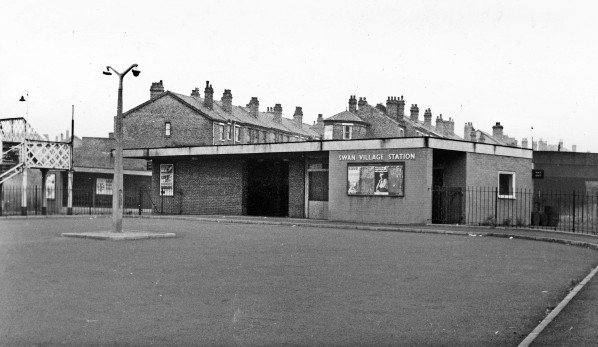
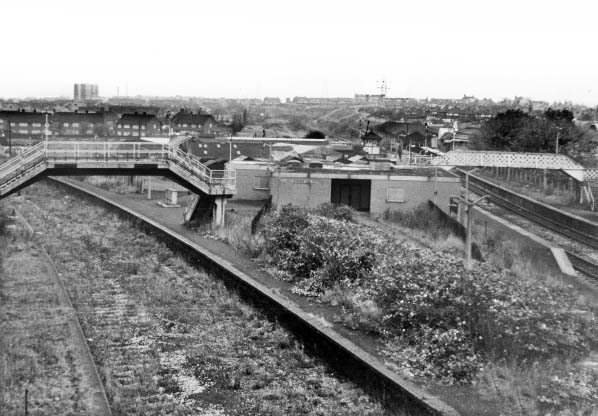 The view from Bilhay Lane in October 1970 with the branch line track having been recently removed and the main building now boarded up.
The view from Bilhay Lane in October 1970 with the branch line track having been recently removed and the main building now boarded up.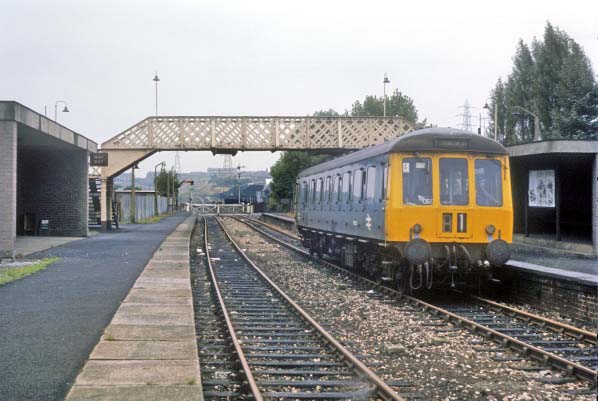 A Tyseley based Rail Blue bubble car arrives at the Birmingham platform on 25 September 1971 although the station was now un-staffed the paltforms and waiting shelters look to be in good order.
A Tyseley based Rail Blue bubble car arrives at the Birmingham platform on 25 September 1971 although the station was now un-staffed the paltforms and waiting shelters look to be in good order.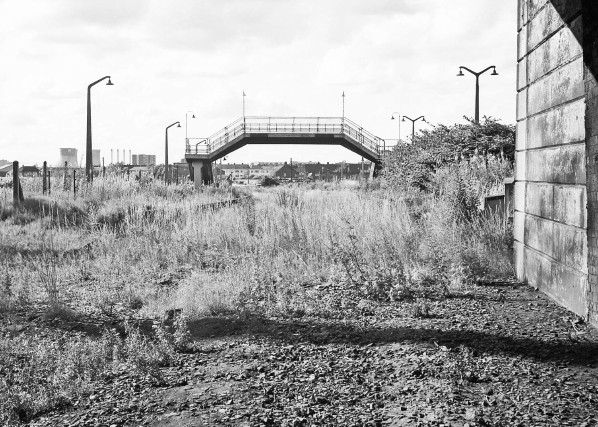
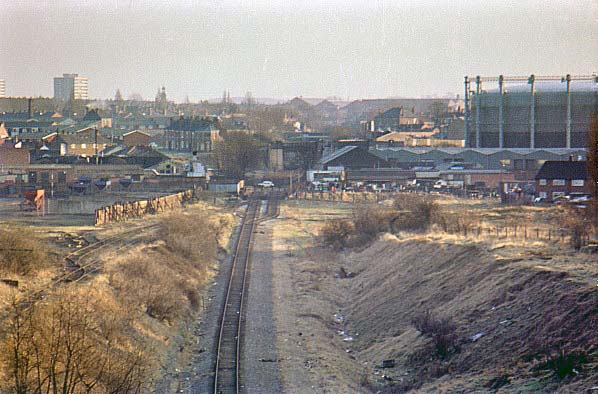 Looking from Hill Top tunnel, in around 1980, towards Birmingham. The station site was just beyond the white car, passing over the crossing, and had been demolished by this time. The line running down to the staion was the remains of the up main line and served the coal depot visible to the left. The depot remained open until December 1981.
Looking from Hill Top tunnel, in around 1980, towards Birmingham. The station site was just beyond the white car, passing over the crossing, and had been demolished by this time. The line running down to the staion was the remains of the up main line and served the coal depot visible to the left. The depot remained open until December 1981.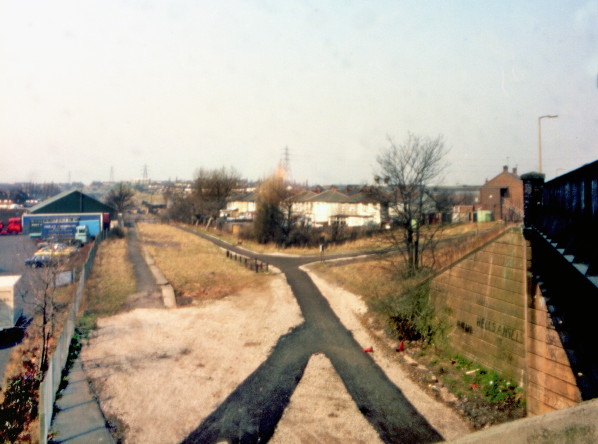
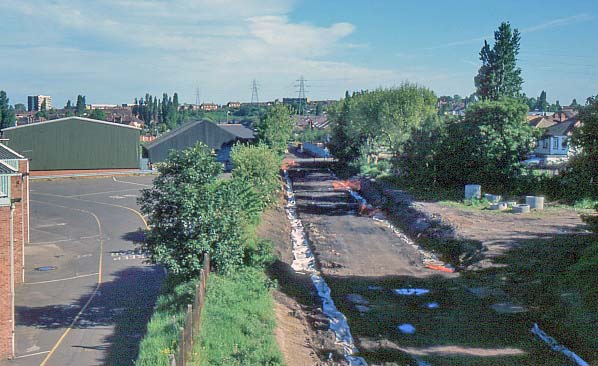 Taken from the same loation as the previous picture but on 9 June 1996 with preperations well underway for the reinstatement of rails through the station site. Drainage channels have been dug and lined with the trackbed taking shape.
Taken from the same loation as the previous picture but on 9 June 1996 with preperations well underway for the reinstatement of rails through the station site. Drainage channels have been dug and lined with the trackbed taking shape.a.jpg)
.jpg) The bricked up aperture which provided access to the station from Bilhay Lane on 5 November 2016.
The bricked up aperture which provided access to the station from Bilhay Lane on 5 November 2016. Home Page
Home Page